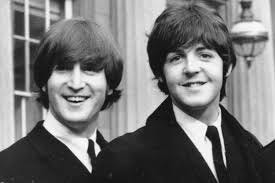I was still at school at the time of what might fancifully be described as my first catering gig. I was instructed to make toast. Whoever needs to have their toast cooked for them at home, you ask?
Paul McCartney. To be fair, it was more a question of setting the table and putting the kettle on.
I was on a sleepover at a schoolfriend’s house, and her mother had instructed us to get breakfast for her older sister’s boyfriend while she went off to teach the oboe to her students (one of whom was George Martin) at the Guildhall School of Music and Drama. The Beatles’ popularity had made holeing up at hotels a challenge - for them, the police, the hotels and surrounding neighbourhoods. So Paul lived in the Ashers’ Wimpole Street house in London’s medical area for around three years, writing songs like I Want to Hold Your Hand, And I Love Her, and Yesterday in the basement music room, as well as A World Without Love for Peter Asher and his friend Gordon Waller. He kept his gold records under the bed in his small attic bedroom and evaded the crowd of groupies always gathered in the street outside No.57 by climbing out of a back window. He would sidle along a parapet into the flat next door, go down into the garden, over a wall, into the back of a young couple’s mews house, then out to the next street where his Aston Martin was parked.
Those weren’t croissant or brioche days. Paul got toasted processed bread, spreadable butter (or maybe it was margarine, fashionably rakish at the time), and a huge tray of jams and honey and Golden Syrup and marmalade and Marmite. I loved staying over. Breakfast was the exact opposite of breakfast at home with its egg boiled so hard you could bounce it off the wall and its toast so sensibly brown. The Ashers’ breakfast felt flamboyant, even if eaten in silence, which doesn’t seem a likely memory. There, the toaster along with the package of sliced bread and the spreads tray sat on the kitchen table, just one of the logical things that made the household seem so easy-going and comforting.
Paul McCartney wasn’t the only person who wanted to be there. People from the musical world and the acting world came and went at all hours. Though seemingly without rules, the house felt exceptionally serene and carefully managed. Yet there was excitement for those like me more used to an everyday routine. I was woken in the middle of the night on one sleep-over by the playing of the grand piano in the sitting room. I crept out of my bed. On the long piano stool sat Dr Asher, a Harley Street consultant, and Dudley Moore. An actor and comedian, he was also a fine musician and composer.
Making breakfast for the Beatles was a whole lot less fraught than making breakfast is now. When avocado toasts hit Instagram, the highest number of admissions to London hospital emergency rooms was for hipsters who’d stabbed themselves in the hand trying to twang the stone out of their avocados. More recently, slap-happy brunch cooks have blistered themselves from sticky splashes, stirring their bubbling shakchouka.
In some parts of the world, breakfast for all is a relatively new institution. Originally, it was a meal reserved for the poor. Only those who had to go out to work needed to fuel themselves up to tackle it. While the Pharoahs of Ancient Egypt don’t seem to have breakfasted, the peasants who worked their royal fields began the day with falafel or a thick soup of ful medames (fava beans) and onions with flatbread, washed down by a thin beer. Ancient Greeks labourers began their day with bread dipped in wine accompanied by figs or olives as did the Romans, although their soldiers were fed a more sustaining polenta porridge. The Aztecs, too, ate a corn porridge, with honey and chillies, or corn tortillas with beans and salsa similar to the chilaquiles in sauce, sprinkled with cheese and served with refried beans and fried eggs popular today at breakfast in Mexico.
Cornmeal also features in the breakfasts of American colonialists breaking their fast with johnnycakes, hoe-cakes, ash-cakes, and more. But despite maple syrup being produced by the indigenous people in the northeastern United States long before the pilgrims arrived, the incomers didn’t pair it with anything until sometime around 1620 when pioneers from the Netherlands brought with them their pancake and waffle traditions.
Popcorn, eaten with milk and sugar or honey, was common for an American breakfast during the 19th century before it moved into darkened cinemas to get covered in ersatz butter and salt. Cold breakfast cereal was introduced in the late 1890s, inspired by the Clean Living Movement and devised to encourage Americans to abandon their by then common breakfasts of bacon, eggs, pancakes and more for something less indulgent. In 1863, James Caleb Jackson, a vegetarian who ran a medical sanitarium in New York, invented the first cold breakfast cereal, made from graham flour and water biscuits so hard it needed soaking in milk. He called it Granula. Unfortunately for him, one of his patients was a Dr John Harvey Kellogg who, in 1878, pinched the idea to serve at his own sanatorium. Before Kellogg went on to create cornflakes, he mixed oatmeal, baked wheat, and cornmeal into Jackson’s recipe, subtly naming his version ‘granola’ to avoid being sued. That’s right: It turns out granola is not a knit-your-own-yogurt hipster invention. It was the purloined idea of a Seventh Day Adventist who, like Jackson, was dedicated to the notion that a good digestion could curb, among other afflictions, self-abuse.
The formal word ‘breakfast’ is thought to have first appeared in Britain in the 15th century when the English upper class and aristocracy also began to eat breakfast, later adding the tea, coffee and chocolate that had been introduced in the 16th century to the meal, turning them into the fashionable elements of the 17th century breakfast.
I was too shy to eat breakfast with Paul McCartney. Besides, I had to get to school. These days, I only have a very strong coffee and nothing else because in my view, an edible breakfast comes two hours too early. But that is a choice I’m fortunate to have. While once breakfast was a meal only for the poor, now, if you’re poor, you can’t afford it. In Britain, 30 percent of children go to school without it. In the US, according to the CDC (Centres for Disease Control), up to 20 percent miss breakfast. While older children not having breakfast could be a choice, most commonly not doing so is because their parents can’t afford to feed them. Before Covid, 1.7 million schoolchildren in Britain were at risk of morning hunger. That figure is now around 2.6 million and rising. In the US before Covid, 5.3 million children suffered from insufficient food. Now, almost 20 percent lower income American children don’t eat breakfast. It’s having a noticeable impact on their ability to absorb their education.
Living on the Isle of Mull (top left hand side off the west cost of Scotland), I ran tiny HotelForTwo. Breakfast included a Bircher muesli. Devised in 1900 by Swiss physician Maximillian Bircher, it wasn’t originally a breakfast dish, but something healthy to serve his sanatorium patients throughout the day before the other courses of a meal. It’s a mixture of rolled oats, grated apple, nuts, seeds and dried fruits in yogurt, put together the night before to mellow. A breeze to make and an internal cuddle for the coming winter, it isn’t hugely expensive and is very sustaining. I’m not taking a photograph - it has an unfortunate resemblance to something a dog coughed up. Besides, you know what it looks like. Here is something more uplifting (peer closely at the lower space:
Serves 4
100g/1 cup rolled oats (Irish or other steel-cut are best)
115g/½ cup full-fat Greek yogurt (non-fat or low-fat yogurt really is a waste of money)
120ml/½ cup milk (or fruit juice, though I’ve not personally ever used that)
2 medium apples, washed then grated on the large holes of a cheese grater, abandoning the core if you need to be told
a selection, in any quantity you like, of nuts (toasted hazelnuts, almonds, pecans, each roughly chopped); seeds (pumpkin, sunflower, chia, etc), dried fruits, chopped if necessary (dates, prunes, apricots, mango, raisins, sultanas, etc)
cinnamon or grated nutmeg to taste, if you absolutely must. I wouldn’t.
Add everything to a bowl, stir well, cover and leave overnight. Thin if necessary the following day with milk. If you prefer to elevate the sweetness of the mixture, stir a spoonful of honey or maple syrup into a cup and pour some of the milk slowly into it while stirring to thin it out then add the liquid to the remaining ingredients.







Make mine granola!
Great piece, Julia!! I may prefer the reading to the eating, but it does go down delightfully!!
xxx Catherine